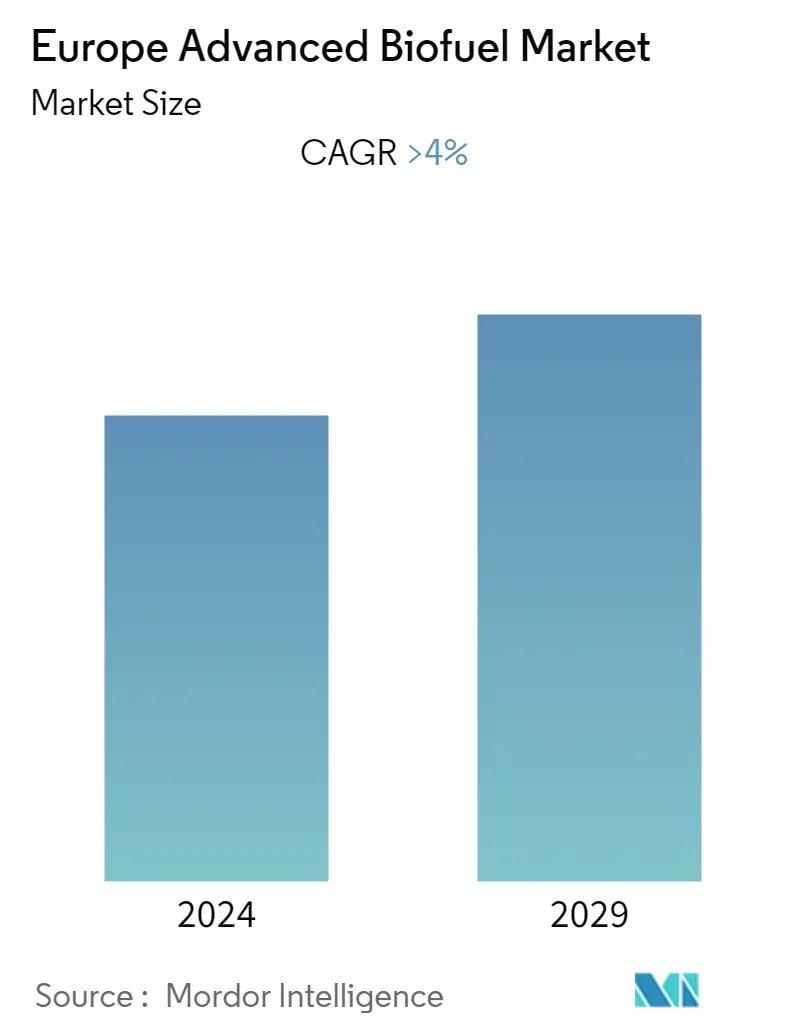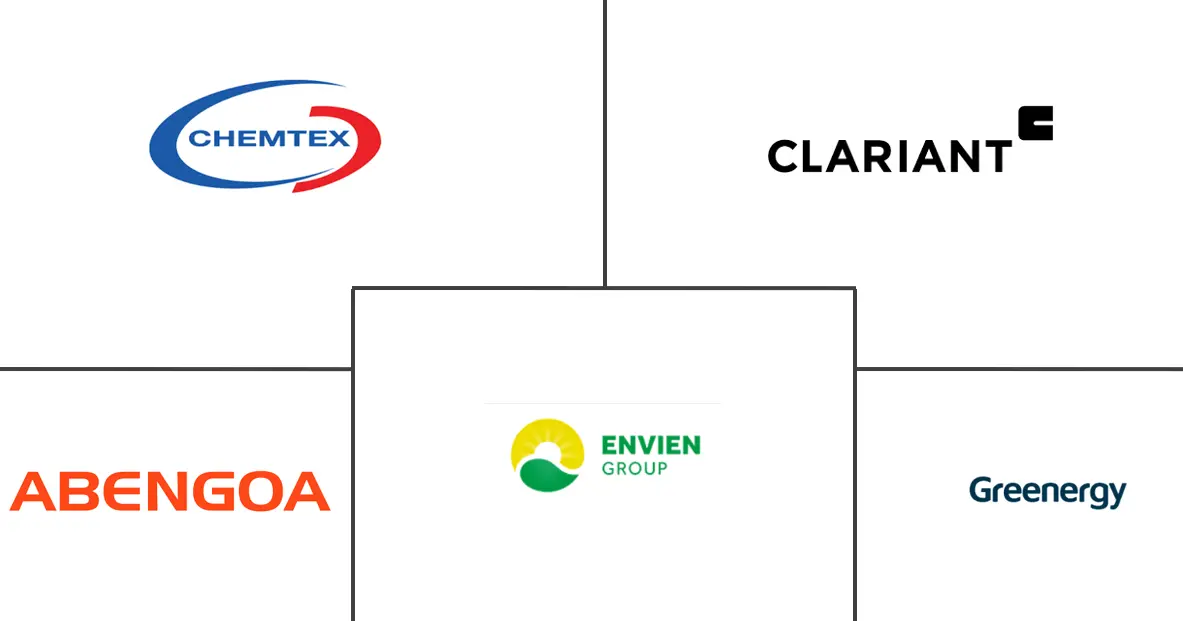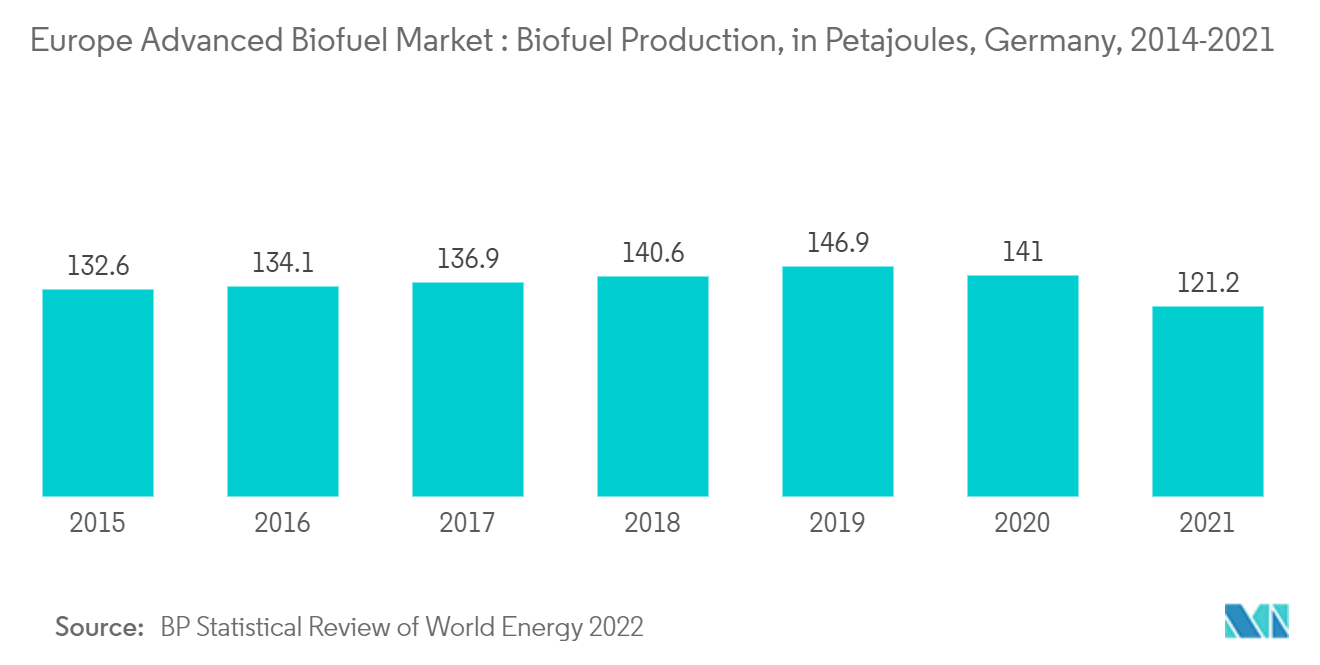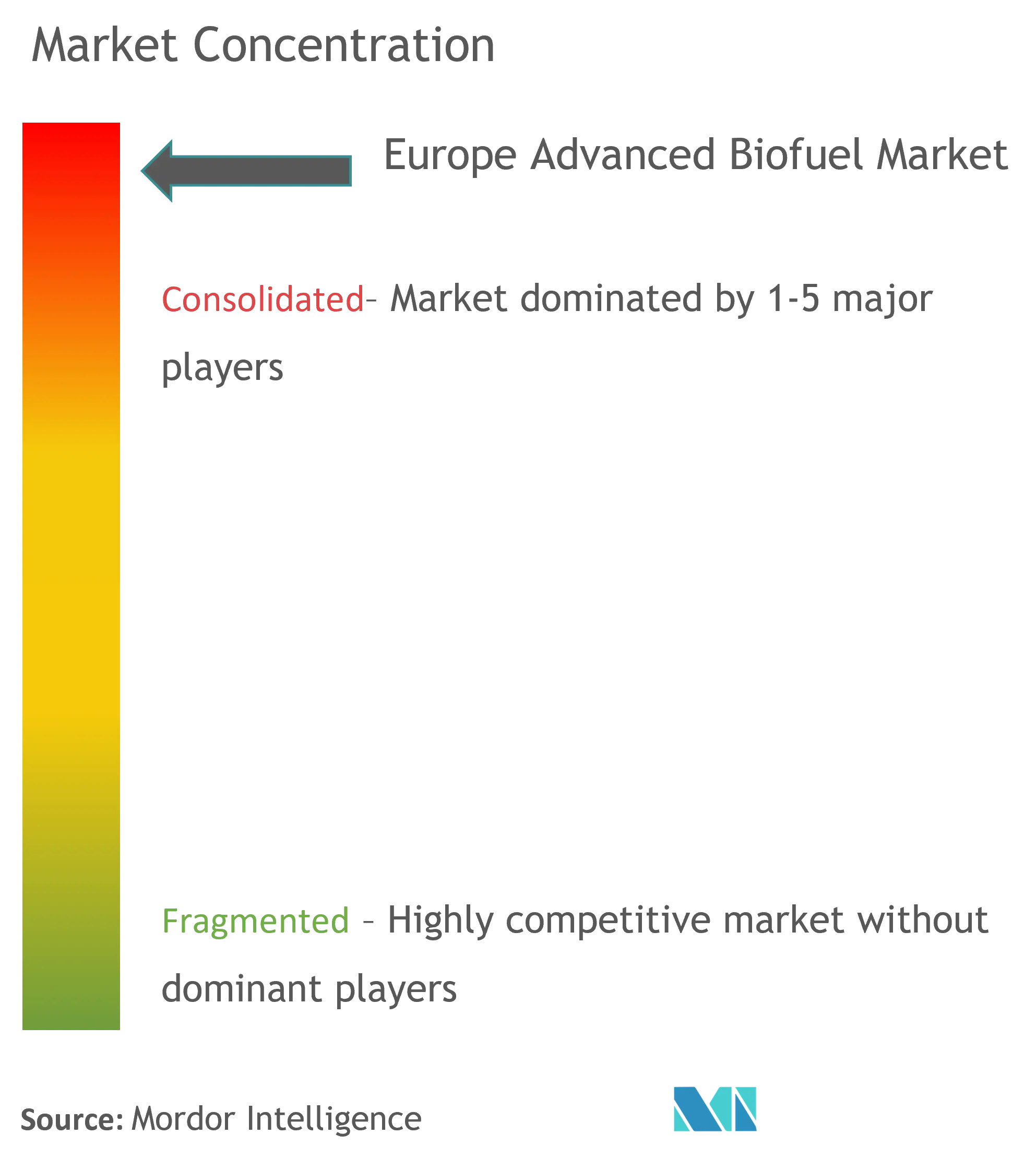Europe Advanced Biofuel Market Size

| Study Period | 2020 - 2029 |
| Base Year For Estimation | 2023 |
| Forecast Data Period | 2024 - 2029 |
| Historical Data Period | 2020 - 2022 |
| CAGR | 4.00 % |
| Market Concentration | High |
Major Players
*Disclaimer: Major Players sorted in no particular order |
Europe Advanced Biofuel Market Analysis
Europe advanced biofuel market is expected to register a CAGR of more than 4% during the forecast period.
The market was negatively impacted by COVID-19 in 2020. Presently, the market has reached pre-pandemic levels.
- Over the long term, the ease in the availability of raw materials and their use being non-food and wastes, along with governmental incentives supporting the development of technologies for producing advanced biofuels, are expected to drive the market during the forecast period.
- On the flip side, the high cost of production of advanced biofuels, even with all the associated benefits, is likely to restrain the market's growth.
- Nevertheless, countries such as Germany, the United Kingdom, the Netherlands, and Sweden are encouraging biodiesel blending to obtain pure biodiesel, which can be used as a fuel source in diesel engines. This will likely provide ample opportunities for the biofuel market in the future.
- Germany is expected to dominate the advanced biofuel market in Europe during the forecast period.
Europe Advanced Biofuel Market Trends
This section covers the major market trends shaping the Europe Advanced Biofuel Market according to our research experts:
Biodiesel Fuel Type to Witness Significant Growth
- Biodiesel is a renewable fuel produced from vegetable oils, such as rapeseed oil, sunflower seed oil, and soybean oil, and used cooking oils or animal fats. Biodiesel has been demonstrated to have significant environmental benefits in terms of decreased global warming impacts, reduced emissions, greater energy independence, and a positive impact on agriculture.
- Biodiesel is used in diesel engine-based cars, trucks, buses, and other vehicles and in stationary heat and power applications. Most biodiesel is made by chemically treating vegetable oils and fats (such as palm, soy, and canola oils, and some animal fats) to produce fatty acid methyl esters (FAME).
- According to the United States Department of Agriculture, biodiesel and a mixture of biodiesel in fossil fuels help to reduce carbon dioxide emissions, especially in the transport sector. The European Commission plans to revise the Renewable Energy Directive, which is expected to increase renewable energy targets in the transport sector.
- The European region witnessed significant growth in biodiesel consumption in recent years, with a rising concern regarding climate change and a need for clean transportation fuel. For instance, according to the Digest on the United Kingdom Energy Statistics, biodiesel consumption in the transport sector increased rapidly from 559 liters in 2015 to about 1,238 liters in 2021.
- This, in turn, is increasing the demand for new biodiesel production facilities to meet the growing regional demand. For instance, in June 2022, Cargill completed its first advanced biodiesel plant in Ghent, Belgium, which converts waste oils and residues into renewable fuel. The advanced biodiesel produced at the facility will be used by the maritime and trucking sectors, enabling customers to lower the carbon footprint associated with their marine and road transport activities.
- Therefore, based on the aforementioned factors, biodiesel fuel type is expected to witness significant growth in Europe's advanced biofuel market during the forecast period.

Germany to Dominate the Market
- Germany is one of the largest producers of biofuel in the world. The country encourages biofuel usage in road transportation to reduce greenhouse gas emissions.
- According to the BP Statistical Review of World Energy 2022, Germany produced 121.2 petajoules of biofuel, equivalent to 3.1% of the world's biofuel production. Germany is one of the largest biodiesel producers in the European Union. According to the United States Department of Agriculture (USFDA), in 2020, Germany produced approximately 3,542 million liters of biodiesel, witnessing an increase of roughly 14.33% compared to 3,106 million liters of biodiesel in 2012.
- In 2018, the European Union adopted the Renewable Energy Directive II (RED II) for the period 2021-2030, which indicated to set a new overall renewable energy target of 32% by 2030 and a 14% target for the transport sector. Furthermore, the European Union has set some minimum biofuel use to achieve the Renewable Energy Directive II. Thus, in accordance with the RED II initiative, the German Government has set a blending target of 0.5% for advanced biofuels by 2025 to foster renewable fuels for transport purposes. Furthermore, Germany has also set a target to reduce GHG emissions by 6% in the transport sector by 2025. Thus, such government initiatives are likely to support the market for advanced biodiesel in Germany during the forecast period.
- Palm oil was used as the primary feedstock in Germany till 2019. However, indirect land use change impacts of biofuels (ILUC) delegated act limits palm oil (the only 'high ILUC risk' feedstock) launched in 2019 limits the use of palm oil in the production of biodiesel till 2023 and then would phase out the use of palm oil entirely by 2030. Germany has set a target of phasing out palm oil by 2023 and helping in reducing GHG emissions.
- Furthermore, in July 2022, DHL Global Forwarding, the air and ocean freight specialist of Germany's Deutsche Post DHL Group, signed an agreement with compatriot liner shipping company Hapag-Lloyd for the use of advanced biofuels. As an initial step, Hapag-Lloyd will ship 18,000 TEU of DHL's volume using advanced biofuels, equivalent to a reduction of 14,000 tons of Well-to-Wake CO2 emissions. The two companies share the vision of decarbonizing container shipping and logistics. Such agreements are likely to create positive demand for the advanced biofuels market in Germany during the forecast period.
- Therefore, based on the above factors, Germany is expected to dominate Europe's advanced biofuel market during the forecast period.

Europe Advanced Biofuel Industry Overview
The Europe advanced biofuel market is consolidated in nature. Some of the major players in the market (in no particular order) include Abengoa Bioenergy, Chemtex Group, Clariant Produkte GmbH, Greenergy International Ltd, and Envien Group.
Europe Advanced Biofuel Market Leaders
-
Abengoa Bioenergy
-
Chemtex Group
-
Clariant Produkte GmbH
-
Greenergy International Ltd
-
Envien Group
*Disclaimer: Major Players sorted in no particular order

Europe Advanced Biofuel Market News
- In July 2022, DHL Global Forwarding, the air and ocean freight specialist of Germany's Deutsche Post DHL Group, signed an agreement with compatriot liner shipping company Hapag-Lloyd for the use of advanced biofuels. As an initial step, Hapag-Lloyd will ship 18,000 TEU of DHL's volume using advanced biofuels, which is equivalent to a reduction of 14,000 tons of Well-to-Wake CO2-emisisons. The two companies share the vision of decarbonizing container shipping and logistics.
- In June 2022, Cargill completed its first state-of-the-art advanced biodiesel plant in Ghent, Belgium, which converts waste oils and residues into renewable fuel. The advanced biodiesel produced at the facility will be used by the maritime and trucking sectors, enabling customers to lower the carbon footprint associated with their maritime and road transport activities.
Europe Advanced Biofuel Market Report - Table of Contents
1. INTRODUCTION
- 1.1 Scope of the Study
- 1.2 Market Definition
- 1.3 Study Assumptions
2. EXECUTIVE SUMMARY
3. RESEARCH METHODOLOGY
4. MARKET OVERVIEW
- 4.1 Introduction
- 4.2 Europe Advanced Biofuel Market Size and Forecast, in USD billion, till 2027
- 4.3 Key Existing and Upcoming Advanced Biofuel Projects, Europe, as of 2021
- 4.4 Recent Trends and Developments
- 4.5 Government Policies and Regulations
-
4.6 Market Dynamics
- 4.6.1 Drivers
- 4.6.2 Restraints
- 4.7 Supply Chain Analysis
-
4.8 Industry Attractiveness - Porter's Five Forces Analysis
- 4.8.1 Bargaining Power of Suppliers
- 4.8.2 Bargaining Power of Consumers
- 4.8.3 Threat of New Entrants
- 4.8.4 Threat of Substitutes Products and Services
- 4.8.5 Intensity of Competitive Rivalry
5. MARKET SEGMENTATION
-
5.1 Raw Material
- 5.1.1 Jatropha
- 5.1.2 Lignocellulose
- 5.1.3 Algae
- 5.1.4 Other Raw Materials
-
5.2 Biofuel Type
- 5.2.1 Cellulosic Ethanol
- 5.2.2 Biodiesel
- 5.2.3 Biogas
- 5.2.4 Biobutanol
- 5.2.5 Other Biofuel Types
-
5.3 Technology
- 5.3.1 Biochemical
- 5.3.2 Thermochemical
-
5.4 Geography
- 5.4.1 Germany
- 5.4.2 France
- 5.4.3 Spain
- 5.4.4 United Kingdom
- 5.4.5 Rest of Europe
6. COMPETITIVE LANDSCAPE
- 6.1 Mergers and Acquisitions, Joint Ventures, Collaborations, and Agreements
- 6.2 Strategies Adopted by Leading Players
-
6.3 Company Profiles
- 6.3.1 Abengoa Bioenergy
- 6.3.2 Chemtex Group
- 6.3.3 Clariant Produkte GmbH
- 6.3.4 Greenergy International Ltd
- 6.3.5 Envien Group
- 6.3.6 DuPont Industrial Biosciences
- 6.3.7 INEOS Bio
- *List Not Exhaustive
7. MARKET OPPORTUNITIES AND FUTURE TRENDS
** Subject To AvailablityEurope Advanced Biofuel Industry Segmentation
Advanced biofuels, also known as second-generation biofuels are renewable fuels that are used as alternatives for gasoline and diesel with very low emissions of greenhouse gases. Advanced biofuels can be manufactured by using various types of biomass like lignocellulose, non-corn starch and sugar.
Europe advanced biofuel market is segmented by raw material, biofuel type, technology, and geography. By raw material, the market is segmented into jatropha, lignocellulose, algae, and other raw materials. By biofuel type, the market is segmented into cellulosic ethanol, biodiesel, biogas, biobutanol, and other biofuel types. By technology, the market is segmented into biochemical and thermochemical. The report also covers the market size and forecasts for the advanced biofuel market across major countries in the European region. For each segment, the market sizing and forecasts have been done based on revenue (USD Billion).
| Raw Material | Jatropha |
| Lignocellulose | |
| Algae | |
| Other Raw Materials | |
| Biofuel Type | Cellulosic Ethanol |
| Biodiesel | |
| Biogas | |
| Biobutanol | |
| Other Biofuel Types | |
| Technology | Biochemical |
| Thermochemical | |
| Geography | Germany |
| France | |
| Spain | |
| United Kingdom | |
| Rest of Europe |
Europe Advanced Biofuel Market Research FAQs
What is the current Europe Advanced Biofuel Market size?
The Europe Advanced Biofuel Market is projected to register a CAGR of greater than 4% during the forecast period (2024-2029)
Who are the key players in Europe Advanced Biofuel Market?
Abengoa Bioenergy, Chemtex Group, Clariant Produkte GmbH, Greenergy International Ltd and Envien Group are the major companies operating in the Europe Advanced Biofuel Market.
What years does this Europe Advanced Biofuel Market cover?
The report covers the Europe Advanced Biofuel Market historical market size for years: 2020, 2021, 2022 and 2023. The report also forecasts the Europe Advanced Biofuel Market size for years: 2024, 2025, 2026, 2027, 2028 and 2029.
Europe Advanced Biofuel Industry Report
Statistics for the 2024 Europe Advanced Biofuel market share, size and revenue growth rate, created by Mordor Intelligence™ Industry Reports. Europe Advanced Biofuel analysis includes a market forecast outlook to 2029 and historical overview. Get a sample of this industry analysis as a free report PDF download.



